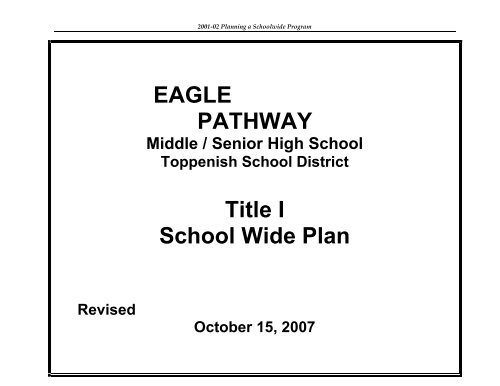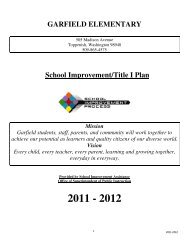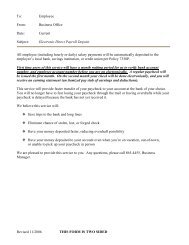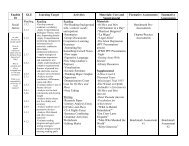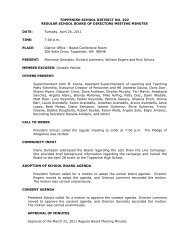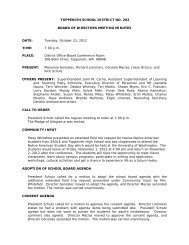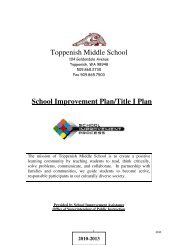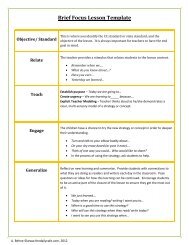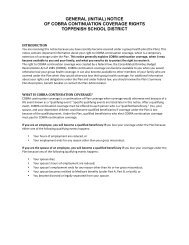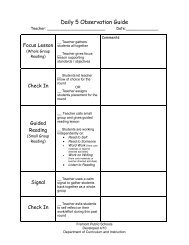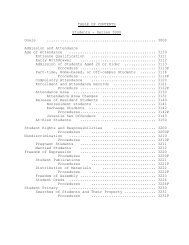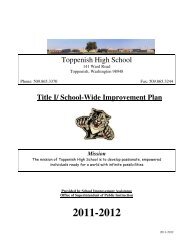EAGLE PATHWAY Title I School Wide Plan - Toppenish School District
EAGLE PATHWAY Title I School Wide Plan - Toppenish School District
EAGLE PATHWAY Title I School Wide Plan - Toppenish School District
Create successful ePaper yourself
Turn your PDF publications into a flip-book with our unique Google optimized e-Paper software.
2001-02 <strong>Plan</strong>ning a <strong>School</strong>wide Program<br />
<strong>EAGLE</strong><br />
<strong>PATHWAY</strong><br />
Middle / Senior High <strong>School</strong><br />
<strong>Toppenish</strong> <strong>School</strong> <strong>District</strong><br />
<strong>Title</strong> I<br />
<strong>School</strong> <strong>Wide</strong> <strong>Plan</strong><br />
Revised<br />
October 15, 2007
The Written <strong>Plan</strong>: General Requirements<br />
<strong>Title</strong> I <strong>School</strong> <strong>Wide</strong> Program <strong>Plan</strong><br />
Assurances<br />
The <strong>Title</strong> I school wide program (SWP) option is designed to help facilitate systemic change in the entire educational<br />
program of a high-poverty school. The purpose of this systemic change process is to increase the academic<br />
achievement of educationally disadvantaged students by providing better services for all students.<br />
The names below certify this <strong>School</strong> <strong>Wide</strong> Program <strong>Plan</strong> is in accordance with all applicable <strong>Title</strong> I rules and<br />
regulations. (List the names and <strong>Title</strong>s of the <strong>District</strong> Implementation Team Members that reviewed the<br />
<strong>School</strong> <strong>Wide</strong> Program <strong>Plan</strong>.)<br />
Name & <strong>Title</strong><br />
Name & <strong>Title</strong><br />
Name & <strong>Title</strong><br />
Name & <strong>Title</strong><br />
Name & <strong>Title</strong><br />
Name & <strong>Title</strong><br />
Name & <strong>Title</strong><br />
Name & <strong>Title</strong><br />
Name & <strong>Title</strong><br />
Name & <strong>Title</strong>
Name & <strong>Title</strong><br />
Name & <strong>Title</strong><br />
Date of <strong>District</strong> Review: ______________10/30/2007________________<br />
<strong>Title</strong> I <strong>School</strong> <strong>Wide</strong> Program <strong>Plan</strong><br />
Date when <strong>Plan</strong> will be<br />
Implemented <strong>Plan</strong> Status: New Revised __X___<br />
<strong>School</strong> <strong>District</strong> Name:<br />
Address:<br />
<strong>Toppenish</strong> <strong>School</strong> <strong>District</strong><br />
306 Bolin Drive<br />
<strong>Toppenish</strong>, WA 98948<br />
<strong>Title</strong> I Coordinator<br />
Jeanette Ozuna<br />
Phone: ( 509 ) 865- 5055 FAX: ( 509 ) 865-2067<br />
E-Mail Address:<br />
ozunajl@toppenish.wednet.edu<br />
Superintendent:<br />
Steve Meyers<br />
E-Mail Address:<br />
Phone: ( 509 ) 865-4455 FAX: ( 509 ) 865-2067<br />
Building Name:<br />
<strong>Toppenish</strong> <strong>School</strong> <strong>District</strong>
Address:<br />
306 Bolin Drive<br />
<strong>Toppenish</strong>, WA 98948<br />
Building Administrator:<br />
Dell Gere<br />
Phone: ( 509 ) 865-3377 FAX: ( 509 ) 865-7327<br />
E-Mail Address:<br />
<strong>School</strong> Enrollment:<br />
Grade Levels:<br />
Free/Reduced Lunch %<br />
dgere@toppenish.wednet.edu__________________________________<br />
_<br />
154<br />
6 - 12<br />
100%<br />
<strong>Plan</strong>ning Team<br />
Parents: Parent Advisory Committee Established 07/2007<br />
Meets once a month—third Tuesday 5 to 6 pm.<br />
Parent Contact: Eligio Jimenez<br />
Certified Staff:<br />
(include position)<br />
Kevin Barr, Social Studies, Health and Fitness<br />
Mindy Krejci, Social Studies<br />
Darla Keatley, English<br />
Alana Delgado, Middle <strong>School</strong>, High <strong>School</strong> Communications<br />
Shelley de Maintenon, Art, Drama, Humanities<br />
Kathy Wegener, Mathematics<br />
Barb Schell, Vocational<br />
Richard Peterson, Middle <strong>School</strong>, High <strong>School</strong> English<br />
Liz Jolliff, Reading, Reading Coach<br />
Frank Chandler, Science, Mathematics<br />
Rosemary Miller, Yakama Native Language<br />
Fred Diaz, Safe Haven Director, ALE’s
Classified Staff:<br />
(include position)<br />
Administrators:<br />
Mary Dale, Secretary<br />
Eligio Jimenez, Home Liaison<br />
Nan Sholtys, Student Assistance Professional<br />
Jose Zamora, Para Professional<br />
Dell Gere, Administrator<br />
<strong>District</strong> Staff:<br />
<strong>Title</strong> I Staff:<br />
Katherine Cove, Special Services<br />
Patty Schmella, Curriculum Director<br />
Carmen Gonzalez, Math Director<br />
Jeanette Ozuna, Federal Programs Director<br />
All Staff<br />
Others (Optional):<br />
<strong>EAGLE</strong> High <strong>School</strong> A.S.B.<br />
<strong>School</strong> <strong>Wide</strong> <strong>Plan</strong>ning Summary<br />
The school wide plan is developed in full consultation with the staff after careful study of data including WASL and<br />
reading assessment results, attendance patterns, discipline patterns, individual student learning plans, staff research,<br />
and anecdotal accounts within the framework of the school’s philosophy and vision, state grade level expectations, and<br />
community considerations as reflected by the district improvement plan. This data driven approach is reflected in<br />
individual classrooms as well.<br />
<strong>School</strong> Improvement plans are aligned with <strong>District</strong> Implementation <strong>Plan</strong>s. The planning cycle begins in August during<br />
the building led Learning Improvement Days and the district led pre-service day program. Evaluation and adjustments<br />
to the plan occur regularly throughout the academic year on optional days and early release time designated for<br />
building led programs. Weekly monitoring of student progress is reported during the staff meetings, and interventions<br />
are designed for students needing support. Evaluation and preliminary recommendations for changes to the school<br />
improvement plan and student learning plans for the following year take place during the last early release session.<br />
This year, 2007-2008, we plan to study results from WASL data, MAPs testing, family surveys, home visits, seven<br />
student-led parent conferences, and community events.
2. Use the following table to summarize the steps and activities of the planning process. Include planning<br />
team meetings, staff work sessions, visitations to schools, and other activities conducted during the needs<br />
assessment, inquiry process and plan development.<br />
Meeting<br />
Participants at Meetings<br />
Dates Agenda Topics/<strong>Plan</strong>ning Steps <strong>Plan</strong>ning All staff Parents<br />
Team<br />
8/20-21/07 LID<br />
X<br />
• Embrace Change<br />
• <strong>Plan</strong> for Excellence<br />
• Quality <strong>School</strong>s<br />
• Review <strong>District</strong> Implementation <strong>Plan</strong><br />
• Discuss Safe Haven/Independent<br />
Study Program<br />
• Student Handbook<br />
• Student Needs and Scheduling<br />
• Transition Procedures between THS<br />
TMS, Safe Haven and <strong>EAGLE</strong><br />
• WASL Results/ Data Carousel<br />
• Family Friendly <strong>Plan</strong>s<br />
• Data Driven Instruction<br />
• Graduation<br />
• 1 st Days Community Building<br />
• Social Issues Curriculum<br />
8/20/07<br />
Staff Orientation - <strong>District</strong> WASL Results,<br />
Sexual Harassment/Bullying Awareness<br />
Training<br />
X<br />
8/20/07<br />
8/21-22/07<br />
PLC<br />
• Individual student placement<br />
(scheduling)<br />
• Reading Assessments<br />
• Credit Profiles<br />
Science, Reading and Math Pre-Scheduling<br />
PLC
8/23/07<br />
• TALONS<br />
• Discipline policy<br />
• Individual Student Needs<br />
• Credit Retrieval/Red Comet<br />
• Attendance/grading policy<br />
9/5/07<br />
X<br />
PLC<br />
• Individual Student Needs<br />
• <strong>School</strong> Safety/Procedures<br />
X<br />
9/5/07<br />
9/12/07<br />
9/18/07<br />
9/19/07<br />
Early Release<br />
• Individual Student Needs<br />
• Safe Haven Outreach Program<br />
• Safe Haven/<strong>EAGLE</strong>/THS/TMS<br />
Transition Procedures<br />
• ALE Problem Solving<br />
• Norms and Protocols<br />
• Observation Protocols<br />
• Family Friendly BBQ <strong>Plan</strong>ning<br />
• <strong>District</strong> Improvement <strong>Plan</strong><br />
Implementation<br />
Family BBQ<br />
Parent Advisory Committee<br />
PLC<br />
• Individual Student Needs<br />
• <strong>Plan</strong>ned Seven Student Led Parent<br />
Conferences<br />
X<br />
X<br />
X<br />
X
9/19-<br />
9/21/07<br />
9/26/07<br />
09/27/07<br />
10/01/07<br />
10/03/07<br />
10/08/07<br />
10/10/07<br />
10/12/07<br />
10/15/07<br />
10/16/07<br />
10/17/07<br />
• Advisory Navigation 101<br />
• Discipline/Suspension Procedures<br />
• Mentor Program<br />
• Role of Reading Coach<br />
• Segmented Math training--Admin<br />
• Family Friendly BBQ, Harvest Dinner<br />
<strong>School</strong>-wide Art Installation Workshop with<br />
Artist in Residence Gloria Gonzáles García<br />
PLC<br />
• Individual Student Needs<br />
• Safety Procedures<br />
Student Led Family Conferences<br />
Early Release—Parent <strong>Plan</strong><br />
Technology plan<br />
PLC<br />
• Individual Student Needs<br />
• Credit Retrieval/Red Comet<br />
• Procedure Committee<br />
Procedure Committee<br />
PLC<br />
Staffing<br />
State Inservice Day<br />
<strong>School</strong> City Data Staff Training<br />
Reading/Writing Initiative Staff Training<br />
Procedure Committee<br />
Parent Advisory Committee<br />
Early Release<br />
SIP revisions/Parent <strong>Plan</strong><br />
X<br />
X<br />
X<br />
X<br />
X
10/24/07<br />
10/30/07<br />
11/07/07<br />
11/08/07<br />
11/14/07<br />
11/20/07<br />
11/28/07<br />
11/29/07<br />
12/4/07<br />
12/5/07<br />
12/12/07<br />
12/18/07<br />
12/19/07<br />
1/2/08<br />
1/09/08<br />
1/10/08<br />
1/15/08<br />
PLC<br />
Student Led Parent Conferences<br />
Early Release—Second Order Change<br />
Training<br />
PLC<br />
PLC<br />
Family Harvest Dinner<br />
Parent Advisory Committee<br />
Early Release—Technology Training/Written<br />
Alternative Learning Experience <strong>Plan</strong>s<br />
PLC<br />
Student Led Parent Conferences<br />
PLC<br />
Early Release—Student Interventions<br />
Yakama Native culture training<br />
Parent Advisory Committee<br />
PLC<br />
PLC<br />
Early Release-Art Integration Training<br />
PLC<br />
<strong>District</strong> <strong>Wide</strong> Optional Day<br />
Parent Advisory Committee
1/16/08<br />
1/17/08<br />
1/30/08<br />
2/6/08<br />
2/7/08<br />
2/20/08<br />
2/25/08<br />
3/5/08<br />
3/18/08<br />
3/19/08<br />
3/21/08<br />
3/26/08<br />
3/27/08<br />
3/28/08<br />
4/09/08<br />
4/10/08<br />
4/16/08<br />
PLC<br />
Student Led Parent Conferences<br />
PLC<br />
Early Release-Content Area Assessment<br />
Training<br />
PLC<br />
PLC<br />
Student Led Family Conferences<br />
Early Release-WASL Proctor Training<br />
Parent Advisory Committee<br />
Early Release—Written Alternative Learning<br />
Experience <strong>Plan</strong>s/ Student Learning <strong>Plan</strong>s<br />
State Inservice Day<br />
PLC<br />
Student Led Family Conferences<br />
PLC<br />
Early Release—Drug/Alcohol Awareness<br />
and At-risk Youth Training<br />
PLC<br />
PLC<br />
Parent Advisory Committee
4/22/08<br />
4/23/08<br />
4/24/08<br />
5/5/08<br />
5/7/08<br />
5/8/08<br />
5/14/08<br />
5/20/08<br />
5/21-22/08<br />
06/03/08<br />
6/4/08<br />
Early Release<br />
PLC<br />
Student Led Parent Conference<br />
Early Release<br />
PLC<br />
PLC<br />
Parent Advisory Committee<br />
Early Release<br />
Senior Boards—TALONS (5 th year plan)<br />
Graduation<br />
PLC<br />
Technical Assistance<br />
Date Provider Type of Assistance
08/07<br />
08/07<br />
8/07-<br />
6/08<br />
09/07<br />
09/07<br />
09/07<br />
9/07<br />
sept/oct<br />
aug/jun<br />
09/07<br />
09/07<br />
09/07<br />
07/08<br />
Reading Institute<br />
Art Institute<br />
Central Washington Writing<br />
Project<br />
TSD—Don Bender<br />
TSD—Patty Schmella<br />
Carmen Gonzalez—TSD<br />
Washington Science<br />
Teachers Association<br />
Bob Shipek<br />
TSD—Patty Schmella<br />
TSD—Bob Shipek<br />
ESD<br />
Darla Keatley Gilman<br />
ESD/TSD/various<br />
professional experts<br />
Range Finder—Darla<br />
Art---Shelley<br />
Shelley/Darla<br />
SIOP—Alana, Richard, Frank, Liz<br />
Writing clinics—Alana, Richard, Liz<br />
Segmented Math—Alana, Richard, Kathy<br />
Inquiry in Action—Frank, Alana<br />
Data Driven—Richard<br />
Reading Coach mentor/mentee Liz/all staff<br />
Technology Training—Richard<br />
Drug/ Alcohol and At-Risk Training --Nan<br />
Writing Seminar Training—all staff<br />
Harassment Training—all staff<br />
Prof Dev calendar list of activities---attached<br />
Staff
STEP 1: Comprehensive Needs Assessment (SIP:<br />
This section summarizes the results of the comprehensive needs assessment conducted by the staff and<br />
school planning team, and is to be included in the written plan.<br />
1. Provide a brief description of your school and community to provide a context for the plan.<br />
<strong>EAGLE</strong> Middle and Senior High <strong>School</strong> is intended to provide an educational setting with smaller class sizes and more<br />
individualized instruction. There are currently 150 students, grades six through twelve, enrolled in the program.<br />
Students are very conscious of the positive image of Pathway schools. Students have either been “assigned” to<br />
<strong>EAGLE</strong> on the basis of academic performance or discipline issues at the high school or middle school or have chosen<br />
to attend based on the experience of friends and family members. Each prospective student and a family member or<br />
advocate are interviewed by staff members and agree to follow school guidelines. During the 2007 – 2008 year an<br />
expanded orientation program also includes a session in creating a purpose statement and code of cooperation and<br />
diagnostic tests in reading. Based on this data the schedule of courses is developed to accommodate the needs of<br />
students each quarter.<br />
The <strong>Toppenish</strong> <strong>School</strong> <strong>District</strong> board members and Superintendents have suggested that<br />
<strong>EAGLE</strong> HS begin a five year transition plan towards a Career Pathway program. The idea has been well received by<br />
staff and students. Also, there was a positive reception by parents at a July 18 th parent advisory meeting. Some of the<br />
first steps towards a Pathway program will be policy changes at <strong>EAGLE</strong> HS in academic expectations, attendance,<br />
grading, scheduling, credit equalization, parent involvement, interventions and course offerings. Our combined goal is<br />
to increase student learning and student achievement as our students prepare for life beyond high school.<br />
Listed below is an outline that briefly describes some of the known expected changes which will be in place for the<br />
August 2007-08 school year.<br />
1. LOWER TRUANCY & DROP OUT RATES/ IMPROVE GRADUATION RATES<br />
a.) Transitions—between TMS/THS/<strong>EAGLE</strong>/SAFE HAVEN/8 TH TO 9 th grade.<br />
b.) Student led parent conferences—8 per year.<br />
c.) PAC—parent advisory meetings once each month.<br />
d.) Eight “23/22 day” grading periods equal to 45, 90, 180 days at THS/TMS.<br />
2. ACADEMICS: CHANGES WITH STRONG INCENTIVES FOR ACHIEVEMENT<br />
a.) Six scheduled academic classes with one advisory class. (Tuesday-Friday)<br />
b.) Pathway Learning Lab (PLL) credit retrieval classes with focus on careers.<br />
c.) Credit Equalization—Students may earn eight credits per year, equal to THS.<br />
d.) <strong>School</strong> to Work
e.) Career Technical Ed/Vocational with shared courses at THS<br />
f.) YV-Tech training<br />
3. INTERVENTIONS/PLACEMENTS/CREDIT RETRIEVAL OPPORTUNITIES<br />
a.) SAFE HAVEN for students with severe truant, safety or academic issues.<br />
b.) DROP IN classes and INDEPENDENT STUDY<br />
c.) RED COMET/VIRTUAL LEARNING<br />
4. ADVISORY/BEHAVIOR MODIFICATIONS/STUDENT DRIVEN ACTIVITIES<br />
a.) NAVIGATION 101—Program with focus on student-driven activities.<br />
b.) “WHY TRY” behavior modification class for all 9 th grade/new students.<br />
c.) Intake interview with parent and student/Freshman Academy.<br />
d.) Student led conferences discussing academics, attendance, learning plans, credit profiles, careers, and fifth<br />
year and beyond plans. Parents and students will discuss and sign contracts for the next grading period.<br />
<strong>EAGLE</strong> students share the challenges faced by alternative school students across the state. A key element in helping<br />
students meet these tests is a comprehensive counseling program with through individual counseling, support group<br />
sessions, and networking with community agencies as well as providing teachers with necessary support in working<br />
effectively with students in the classroom.<br />
Staff members begin with each student’s personal and academic strengths and work with them to build success upon<br />
success as students make progress towards meeting graduation requirements and planning for the future.<br />
2. Describe the process used to collect and analyze data across the five school wide planning dimensions:<br />
student achievement, organization of the school year and day, professional development, curriculum and<br />
instruction, and family and community involvement.<br />
The following grid outlines the process of data collection and analysis at <strong>EAGLE</strong> Middle/ Senior High <strong>School</strong>.<br />
<strong>Plan</strong>ning Dimension Data Collection Data Analysis<br />
Student Achievement<br />
W.A.S.L.<br />
Gates<br />
DIBELS<br />
CORE Phonics Survey<br />
Corrective Reading Placement<br />
NAEP<br />
Attendance patterns<br />
Student learning plans<br />
L.I.D. August 2007<br />
August 2007, January 08, May 08<br />
October, January, March, June
Organization of the school year<br />
and day<br />
Professional development<br />
Curriculum and Instruction<br />
Family and community<br />
involvement<br />
Seven student led parent<br />
conferences update of credit<br />
profiles by students with<br />
assistance of advisory teachers<br />
Home visits<br />
Purpose Statement<br />
Code of Cooperation<br />
at beginning of year<br />
Day One of each new quarter:<br />
students review grades earned,<br />
update credit profiles and register<br />
for new courses<br />
Survey needs individual / school<br />
wide<br />
Schedule based on results of<br />
diagnostics and state /district<br />
graduation requirements.<br />
Research: district in-service,<br />
conferences, individual and<br />
building wide reading, PLC<br />
Discussions with families, during<br />
interview of new students.<br />
Parent Advisory Meetings (PAC)<br />
Family BBQ, Harvest dinner,<br />
student led conferences, informal<br />
school visits by school board,<br />
awards assemblies<br />
Family Visits<br />
One every 22 day grading period<br />
Throughout year<br />
Developed by staff and student<br />
body at beginning of academic<br />
year.<br />
Reviewed during orientation<br />
sessions for new students.<br />
Day One of each new quarter:<br />
students review grades earned,<br />
update credit profiles and register<br />
for new courses<br />
Review and develop professional<br />
development calendar during<br />
L.I.D./staff meetings/PLC<br />
Periodic review of curriculum and<br />
instructional strategies during<br />
early release and optional day<br />
programs.<br />
Review findings in relation to<br />
needs of <strong>EAGLE</strong> students.<br />
Implement, monitor, assess,<br />
refine.<br />
<strong>EAGLE</strong> program and student’s<br />
records are reviewed by principal,<br />
new student family, and staff<br />
during the interview.<br />
One each month.<br />
Student, family, staff<br />
<strong>District</strong> Home Liaisons/ Teachers
3. Areas of Strength and Areas in Need of Improvement:<br />
This section must be based on data gathered in your needs assessment, across the dimensions (student<br />
achievement, professional development, curriculum and instruction, family and community involvement,<br />
and organization of the school year and day).<br />
a. Summarize findings of the strengths and weaknesses of your current program as revealed through<br />
data analysis and include samples of that data analysis (i.e. surveys, test results, etc.)<br />
The emphasis on the power of relationships provides the foundation of the strengths of the current program of <strong>EAGLE</strong><br />
Middle / Senior High <strong>School</strong>. A highly qualified and dedicated staff is focused on improving student achievement within<br />
an environment that nurtures the whole being in a learning community. Staff members search out ways to increase<br />
effectiveness through participation and contributions at district and state level; attendance at conferences (individuals<br />
and teams); participation in workshops as individuals and teams; full, frank, respectful consultation at weekly PLC<br />
meetings and individual and group professional readings that are shared with staff.<br />
There is systematic review of testing data including WASL and other classroom based assessments results. A<br />
schedule of classes is developed based on these needs as opposed to assigning students to classes in a pre-existing<br />
schedule.<br />
Another strength of the program is an array of ASB student leaders developing attitudes of service, volunteering, and<br />
commitment to excellence.<br />
Three key weaknesses will be addressed by the revised plan.<br />
Currently, family involvement occurs on a surface level. Students interview at time of enrollment and occasionally with<br />
the counselor, administrator, or their child’s teachers. Families attend such school organized events such as Family<br />
BBQ, Family Nights, and the Harvest Dinner.<br />
WASL testing has been difficult due to the complexities in accurately identifying the current tenth grade students, the<br />
transition involving tenth grade students during the testing date, and attendance during the entire testing window.<br />
A third area of concern is the poor attendance and low graduation rate. Many students leave <strong>EAGLE</strong> during their ninth<br />
grade year.
Step 2. <strong>School</strong>wide Reform Strategies<br />
Research<br />
Describe how the team and staff investigated and selected the solutions. Include a description of how the<br />
staff:<br />
Staff studied and investigated best practices and research through:<br />
Participation in district in-service such as Quality in Education: Data Driven Instruction, SIOP, and Family Friendly<br />
<strong>School</strong>s;<br />
Participation in conferences such as OSPI Institutes and ESD 105 Training opportunities<br />
Formation of PLC and Collaboration at site meetings<br />
Graduate work and participation in subject-area workshops<br />
Professional reading<br />
Involvement in professional organizations such as NCTM and NCTE and action research.<br />
Visited and/or contacted successful schools and programs<br />
Attendance at WALA conference.<br />
Received input from the whole staff and parents as the plan was developed.<br />
Staff input In the research process has been strong with opportunities for study, discussion, planning, and evaluation<br />
during weekly staff meetings, early release sessions and in-service days.<br />
Input from students occurs informally in classrooms and more formerly through quarterly review of the update of their<br />
credit profiles and through student government. Added Navigation 101 grant to assist with Advisory and parent<br />
conferences.<br />
Solutions include:
school wide development of purpose statement and code of cooperation<br />
development of an orientation process which includes diagnostic testing<br />
develop schedule of course offerings based on results of diagnostics<br />
quarterly examination by students of their progress toward graduation<br />
through reviewing their most recent grades, updating their credit<br />
profile, and registering for classes that will help them achieve their goals<br />
new reading classes tailored for students needing work with decoding and fluency;<br />
collaboration with a part time reading coach.<br />
<strong>School</strong> wide Program Goals<br />
All <strong>EAGLE</strong> students will increase reading literacy by 10% as measured by<br />
yearly WASL<br />
All <strong>EAGLE</strong> students will increase the number of students meeting<br />
standards in Mathematics by 10% as measured by yearly WASL.<br />
As measured by EES and FFS surveys, the <strong>EAGLE</strong> schools will increase<br />
connected-inclusive relationships with families and community by 10%<br />
by 2007.<br />
<strong>EAGLE</strong> graduation rate will increase by 1% per year.<br />
a. Instructional Program<br />
1. Describe the key components of the instructional program of the school. Explain how the school will<br />
organize and deliver instruction to improve learning for all students. Describe how the instruction<br />
will be different and more effective as a result of school wide planning.
<strong>EAGLE</strong> Middle / Senior High <strong>School</strong> offers a comprehensive program for students to meet state graduation<br />
requirements.<br />
All staff members will meet regularly with the on-site reading coach to implement programs to meet the specific<br />
reading instruction needs of students. A system of interventions designed for the unique circumstances of <strong>EAGLE</strong><br />
students will be implemented, monitored, evaluated, and revised. Content area teachers will be trained and<br />
coached to incorporate one new reading strategy per quarter in classes.<br />
2. Describe the components of the instructional program that will meet the needs of special populations<br />
(i.e. ELL, TAG).<br />
All <strong>EAGLE</strong> staff will work with the district’s curriculum director to research diagnostic tools to identify student’s<br />
needs. We will collaborate with the Special Education director, Migrant director, coaches, ESD, OSPI and the<br />
Federal Programs director to find the funding necessary for these tools.<br />
<strong>EAGLE</strong> members will take SIOP training to tailor the program to meet the special needs of the school’s ELL<br />
population.
2001-02 <strong>Plan</strong>ning a <strong>School</strong>wide Program<br />
Strategy, Method, or Action<br />
<strong>EAGLE</strong> graduation rate will increase by 1%<br />
per year.<br />
Instructional Strategies<br />
To support this goal<br />
<strong>EAGLE</strong> Middle / Senior High <strong>School</strong> offers<br />
a comprehensive program for students to<br />
meet state graduation requirements.<br />
A system of interventions designed for the<br />
unique circumstances of <strong>EAGLE</strong> students<br />
will be implemented, monitored,<br />
evaluated, and revised.<br />
Improve Graduation Rate<br />
IMPLEMENTATION/ACTION PLAN<br />
Who is Timeline<br />
Responsible? When will this<br />
Who will provide<br />
the leadership to<br />
assure that this<br />
strategy is<br />
accomplished?<br />
strategy or action<br />
begin and end?<br />
2007-2008<br />
All <strong>EAGLE</strong> STAFF<br />
All <strong>EAGLE</strong> staff,<br />
students and<br />
families<br />
2007-08<br />
Resources<br />
What existing<br />
resources, (or<br />
resources you will<br />
have as you<br />
implement this plan)<br />
will you use to<br />
accomplish this<br />
strategy?<br />
Admin/read<br />
coach/Tech<br />
Evidence<br />
What indicators will<br />
demonstrate progress in<br />
the implementation of<br />
this strategy?<br />
Improved student<br />
performances<br />
WASL achievement<br />
Improved student<br />
performances<br />
Admin/read coach/Tech WASL achievement<br />
Evaluation Methods<br />
How will you gather the<br />
evidence needed to<br />
demonstrate progress and<br />
achievement of this strategy<br />
Graduation rates increase<br />
1% each year.<br />
Graduation rates increase 1%<br />
each year.<br />
Professional Development<br />
To support this goal:<br />
The <strong>Toppenish</strong> school district administrators<br />
are learning and training together to provide inhouse<br />
professional opportunities for their staff.<br />
The <strong>EAGLE</strong> administrator has been actively<br />
engaged in reading and role-playing many<br />
cutting edge concepts and principles. through<br />
FFS training, book readings and seminars of<br />
educators; DuFours, Elmore, Platt, and<br />
Maning.<br />
<strong>EAGLE</strong> staff will be involved with the WASL<br />
scoring workshops, training on assessments,<br />
ELL/SIOP training, Buck Evans student driven<br />
instruction techniques, and intervention<br />
curriculum training.<br />
All <strong>EAGLE</strong> staff 2007-08<br />
Admin/coordinators<br />
Admin/read coach/Tech Improved student<br />
performances<br />
WASL achievement Graduation rates increase 1%<br />
each year.
Family / Community Involvement<br />
IMPLEMENTATION/ACTION PLAN<br />
Strategy, Method, or Action<br />
What will you do<br />
Increase opportunities for family<br />
participation through<br />
home visits<br />
quarterly family nights<br />
Who is<br />
Responsible?<br />
Who will provide the<br />
leadership to assure<br />
that this strategy is<br />
accomplished?<br />
Timeline<br />
When will this<br />
strategy or action<br />
begin and end?<br />
Resources<br />
What existing resources,<br />
(or resources you will<br />
have as you implement<br />
this plan) will you use to<br />
accomplish this strategy?<br />
Evidence<br />
What indicators will<br />
demonstrate<br />
progress in the<br />
implementation of<br />
this strategy?<br />
Evaluation Methods<br />
How will you gather the<br />
evidence needed to<br />
demonstrate progress and<br />
achievement of this<br />
strategy<br />
Instructional Strategies<br />
To support this goal<br />
Family Visits by teachers in the student’s<br />
homes.<br />
Student Led Family Conferences<br />
Family Nights at <strong>EAGLE</strong><br />
Communications (dual language):<br />
Personal visits, phone calls, and mailed<br />
letters.<br />
During the academic year, two staff<br />
member will participate in the district team<br />
training in Family Friendly <strong>School</strong>s and<br />
report regularly at <strong>EAGLE</strong> staff meetings.<br />
Staff/families/adm 2007-08 Admin/read coach/Tech<br />
Improved student<br />
performances<br />
WASL achievement<br />
Graduation rates increase 1%<br />
each year.<br />
Professional Development<br />
To support this goal:<br />
<strong>EAGLE</strong> staff will be involved with the<br />
WASL scoring workshops, training on<br />
assessments, ELL/SIOP training,<br />
Buck Evans student driven instruction<br />
techniques, and intervention<br />
curriculum training.<br />
Staff/families/adm 2007-08 Admin/read coach/Tech<br />
Improved student<br />
performances<br />
WASL achievement<br />
Graduation rates increase 1%<br />
each year.
Mathematics across the curriculum<br />
IMPLEMENTATION/ACTION PLAN<br />
Strategy, Method, or Action<br />
What will you do<br />
All <strong>EAGLE</strong> students will increase the<br />
number of students meeting standards<br />
in Mathematics by 10% as measured<br />
by yearly WASL.<br />
Who is<br />
Responsible?<br />
Who will provide the<br />
leadership to assure<br />
that this strategy is<br />
accomplished?<br />
Timeline<br />
When will this<br />
strategy or action<br />
begin and end?<br />
Resources<br />
What existing resources,<br />
(or resources you will<br />
have as you implement<br />
this plan) will you use to<br />
accomplish this strategy?<br />
Evidence<br />
What indicators will<br />
demonstrate<br />
progress in the<br />
implementation of<br />
this strategy?<br />
Evaluation Methods<br />
How will you gather the<br />
evidence needed to<br />
demonstrate progress and<br />
achievement of this strategy<br />
Instructional Strategies<br />
To support this goal<br />
All <strong>EAGLE</strong> staff will work with the<br />
district’s curriculum director to<br />
research diagnostic tools to<br />
identify student’s needs. We will<br />
collaborate with the Special<br />
Education director, Migrant<br />
director, coaches, ESD, OSPI<br />
and the Federal Programs<br />
director to find the funding<br />
necessary for these tools.<br />
Staff/families/adm 2007-08 Admin/read coach/Tech<br />
Improved student<br />
performances<br />
WASL achievement<br />
students meeting standards in<br />
Mathematics by 10% as measured<br />
by yearly WASL<br />
Professional Development<br />
To support this goal:<br />
All <strong>EAGLE</strong> staff will work with the<br />
district’s curriculum director to<br />
research diagnostic tools to<br />
identify student’s needs. We will<br />
collaborate with the Special<br />
Education director, Migrant<br />
director, coaches, ESD, OSPI<br />
and the Federal Programs<br />
director to find the funding<br />
necessary for these tools.<br />
Staff/families/adm 2007-08 Admin/read coach/Tech<br />
Improved student<br />
performances<br />
WASL achievement<br />
Increase students meeting<br />
standards in Mathematics by<br />
10% as measured by yearly<br />
WASL<br />
<strong>EAGLE</strong> members will take SIOP<br />
training to tailor the program to<br />
meet the special needs of the<br />
school’s ELL population.
Standards Based Instruction – Reading across the curriculum<br />
IMPLEMENTATION/ACTION PLAN<br />
Strategy, Method, or Action<br />
What will you do<br />
All <strong>EAGLE</strong> students will increase reading<br />
literacy by 10% as measured by yearly WASL<br />
Staff/families/adm 2007-08 Admin/read coach/Tech Improved student<br />
performances<br />
WASL achievement<br />
students will increase reading<br />
literacy by 10% as measured by<br />
yearly<br />
WASL<br />
Instructional Strategies<br />
To support this goal<br />
<strong>EAGLE</strong> Middle / Senior High <strong>School</strong> offers<br />
a comprehensive program for students to<br />
meet state graduation requirements.<br />
Staff/families/<br />
adm<br />
2007-08 Admin/read coach/Tech<br />
Improved student<br />
performances<br />
WASL achievement<br />
students will increase reading<br />
literacy by 10% as measured<br />
by yearly WASL<br />
All staff members will meet regularly with<br />
the on-site reading coach to implement<br />
programs to meet the specific reading<br />
instruction needs of students. A system of<br />
interventions designed for the unique<br />
circumstances of <strong>EAGLE</strong> students will be<br />
implemented and monitored, evaluated,<br />
and revised. Content area teachers will be<br />
trained and coached to incorporate one<br />
new reading strategy per quarter in classes.<br />
Professional Development<br />
To support this goal:<br />
The <strong>Toppenish</strong> school district administrators are<br />
learning and training together to provide inhouse<br />
professional opportunities for their staff.<br />
The <strong>EAGLE</strong> administrator has been actively<br />
engaged in reading and role-playing many<br />
cutting edge concepts and principles. through<br />
FFS training, book readings and seminars of<br />
educators; DuFours, Elmore, Platt, and Maning.<br />
Staff/families/<br />
adm<br />
2007-08 Admin/read coach/Tech<br />
Improved student<br />
performances<br />
WASL achievement<br />
students will increase reading<br />
literacy by 10% as measured<br />
by yearly WASL<br />
<strong>EAGLE</strong> staff will be involved with the WASL<br />
scoring workshops, training on assessments,<br />
ELL/SIOP training, Buck Evans student driven<br />
instruction techniques, and intervention<br />
curriculum training.
Standards Based Instruction –Art across the curriculum<br />
IMPLEMENTATION/ACTION PLAN<br />
Strategy, Method, or Action<br />
What will you do<br />
Integrate reading across the<br />
curriculum<br />
Integrate standards based arts<br />
instruction across the curriculum<br />
Who is Responsible? Timeline Resources<br />
Who will provide the When will this strategy What existing resources, (or<br />
leadership to assure that or action begin and<br />
this strategy is<br />
end?<br />
accomplished?<br />
resources you will have as<br />
you implement this plan) will<br />
you use to accomplish this<br />
strategy?<br />
Evidence<br />
What indicators will<br />
demonstrate progress in<br />
the implementation of this<br />
strategy?<br />
Evaluation Methods<br />
How will you gather<br />
the evidence needed<br />
to demonstrate<br />
progress and<br />
achievement of this<br />
strategy<br />
Instructional Strategies<br />
To support this goal<br />
Integration of one new reading<br />
strategy each quarter in each<br />
course offered at <strong>EAGLE</strong><br />
Systematic integration of arts<br />
standards in one assignment /<br />
project/or unit in each content<br />
area<br />
Professional Development<br />
To support this goal:<br />
SIOP<br />
Consultation / coaching in reading<br />
Arts mentors<br />
OSPI Conferences / Institutes<br />
WALA conference<br />
Staff 2007 – 2007<br />
Repeats<br />
2007 - 2008<br />
<strong>District</strong><br />
<strong>District</strong> reading consultants 2006 – 2008<br />
Building:<br />
Gloria Garcia<br />
Visual Arts<br />
VSA:<br />
Dance, Drama,<br />
Music<br />
Repeats<br />
2007 - 2008<br />
<strong>District</strong>: early release,<br />
reading consultant,<br />
materials<br />
State/ federal programs<br />
Grant<br />
<strong>District</strong><br />
Building / VSA<br />
<strong>Title</strong> programs<br />
Attendance<br />
Credits earned<br />
Improved reading<br />
scores<br />
Attendance records<br />
Credit profiles<br />
Reading assessments<br />
Systematic assessment<br />
Arts standards integration chart and intervention<br />
Lesson plans<br />
Student work<br />
Attendance<br />
Lesson plans<br />
Credits earned<br />
Improved reading<br />
Student work<br />
scores<br />
Professional Growth<br />
interviews with staff<br />
Arts standards integration chart regarding quality / results<br />
of professional<br />
development<br />
<strong>District</strong><br />
Staff


